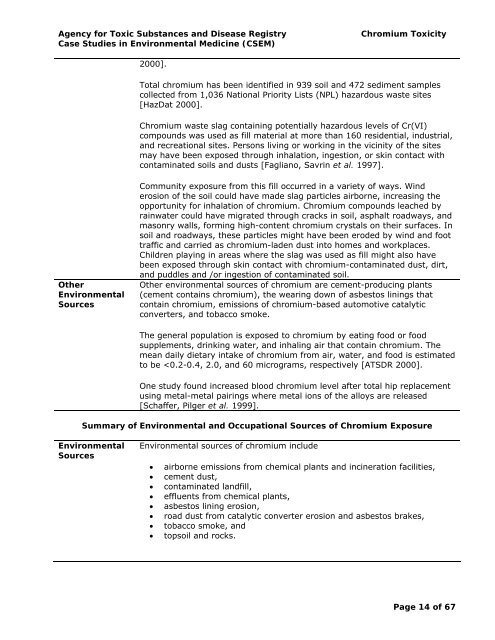(Cr) Toxicity | ATSDR - CSEM - Agency for Toxic Substances and ...
(Cr) Toxicity | ATSDR - CSEM - Agency for Toxic Substances and ...
(Cr) Toxicity | ATSDR - CSEM - Agency for Toxic Substances and ...
You also want an ePaper? Increase the reach of your titles
YUMPU automatically turns print PDFs into web optimized ePapers that Google loves.
<strong>Agency</strong> <strong>for</strong> <strong>Toxic</strong> <strong>Substances</strong> <strong>and</strong> Disease Registry Chromium <strong><strong>Toxic</strong>ity</strong><br />
Case Studies in Environmental Medicine (<strong>CSEM</strong>)<br />
Other<br />
Environmental<br />
Sources<br />
2000].<br />
Total chromium has been identified in 939 soil <strong>and</strong> 472 sediment samples<br />
collected from 1,036 National Priority Lists (NPL) hazardous waste sites<br />
[HazDat 2000].<br />
Chromium waste slag containing potentially hazardous levels of <strong>Cr</strong>(VI)<br />
compounds was used as fill material at more than 160 residential, industrial,<br />
<strong>and</strong> recreational sites. Persons living or working in the vicinity of the sites<br />
may have been exposed through inhalation, ingestion, or skin contact with<br />
contaminated soils <strong>and</strong> dusts [Fagliano, Savrin et al. 1997].<br />
Community exposure from this fill occurred in a variety of ways. Wind<br />
erosion of the soil could have made slag particles airborne, increasing the<br />
opportunity <strong>for</strong> inhalation of chromium. Chromium compounds leached by<br />
rainwater could have migrated through cracks in soil, asphalt roadways, <strong>and</strong><br />
masonry walls, <strong>for</strong>ming high-content chromium crystals on their surfaces. In<br />
soil <strong>and</strong> roadways, these particles might have been eroded by wind <strong>and</strong> foot<br />
traffic <strong>and</strong> carried as chromium-laden dust into homes <strong>and</strong> workplaces.<br />
Children playing in areas where the slag was used as fill might also have<br />
been exposed through skin contact with chromium-contaminated dust, dirt,<br />
<strong>and</strong> puddles <strong>and</strong> /or ingestion of contaminated soil.<br />
Other environmental sources of chromium are cement-producing plants<br />
(cement contains chromium), the wearing down of asbestos linings that<br />
contain chromium, emissions of chromium-based automotive catalytic<br />
converters, <strong>and</strong> tobacco smoke.<br />
The general population is exposed to chromium by eating food or food<br />
supplements, drinking water, <strong>and</strong> inhaling air that contain chromium. The<br />
mean daily dietary intake of chromium from air, water, <strong>and</strong> food is estimated<br />
to be

















